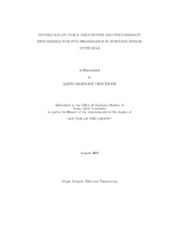| dc.description.abstract | Recent years have seen a tremendous growth in the development of small sensing
devices capable of data processing and wireless communication through their embed-
ded processors and radios. Wireless Sensor Networks (WSNs) are ad hoc networks
consisting of such devices gaining importance due to their emerging applications. For
a meaningful processing of the information sensed by WSN nodes, the clocks of these
individual nodes need to be matched through some well de¯ned procedures. This
dissertation focuses on deriving e±cient estimators for the clock parameters of the
network nodes for synchronization with the reference node and the estimators variance
thresholds are obtained to lower bound the maximum achievable performance.
For any general time synchronization protocol involving a two way message ex-
change mechanism, the BLUE-OS and the MVUE of the clock o®set between them is
derived assuming both symmetric and asymmetric exponential network delays. Next,
with the inclusion of clock skew in the model, the joint MLE of clock o®set and skew
under both the Gaussian and the exponential delay model and the corresponding al-
gorithms for ¯nding these estimates are presented. Also, for applications where even
clock skew correction cannot maintain long-term clock synchronization, a closed-form expression for the joint MLE for a quadratic model is obtained.
Although the derived MLEs are not computationally very complex, two compu-
tationally e±cient algorithms have been proposed to estimate the clock o®set and
skew regardless of the distribution of the delays. Afterwards, extending the idea of
having inactive nodes in a WSN overhear the two-way timing message communication
between two active (master and slave) nodes, the MLE, the BLUE-OS, the MVUE
and the MMSE estimators for the clock o®sets of the inactive nodes located within
the communication range of the active nodes are derived, hence synchronizing with
the reference node at a reduced cost.
Finally, focusing on the the one-way timing exchange mechanism, the joint MLE
for clock phase o®set and skew under exponential noise model and the Gibbs Sampler
for a receiver-receiver protocol is formulated and found via a direct algorithm. Lower
and upper bounds for the MSE of JMLE and Gibbs Sampler are introduced in terms
of the MSEs of the MVUE and the conventional BLUE, respectively. | en |


